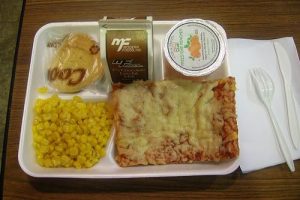Healthy Foods Improve Education
Experts agree that the nutrition provided to millions of children through school meal programs is detrimental to their health. (1) A 2008 analysis of school lunches by the Institute of Medicine (IOM) concluded that American kids consume few fruits and vegetables in their cafeterias. (2) Instead, most of their meals contain, trans-fats, salts, and refined grains, leading to obesity and poor eating habits.
Fortunately, individuals such as Michelle Obama are making moves to improve food programs in schools. In 2010, Congress voted to repair the nation’s school lunch program by creating the Healthy, Hunger-Free Kids Act (HHFKA). These higher standards are meant to increase the availability and portion sizes of fruits, vegetables and whole grains, removing trans fats, and limiting sodium levels. (3)
Harvard School of Public Health performed research to measure the effects of HHFKA. Their findings show fruit selection increasing 23%, and vegetable consumption up 16%. (4)
Following the HHFKA implementation, studies also showed an increase in school lunch revenue. Food waste did not increase, and participation is increasing. The USDA expects participation to keep climbing. (5)
We know processed foods make us lethargic, unmotivated, and unable to concentrate. Better eating habits will improve students’ performance in every level of education. Our hope is for continued progress.
Previous Section:
Acknowledgments
Next Section:
Acknowledgments
Thank you for reading!
Please donate to help us publish this book.
PayPal: trevesbruno@gmail.com
Venmo: @Bruno-Treves
Sources:
(1) https://www.cnn.com/2017/03/21/health/school-nutrition-program-benefits/index.html
(2) https://www.scientificamerican.com/article/how-to-improve-american-school-lunches/
(3) https://www.scientificamerican.com/article/how-to-improve-american-school-lunches/
(4) https://www.scientificamerican.com/article/how-to-improve-american-school-lunches/
(5) https://www.fns.usda.gov/pressrelease/2014/009814


